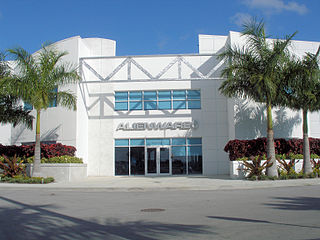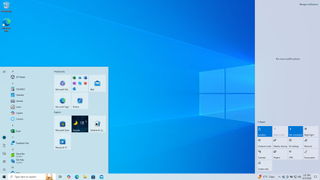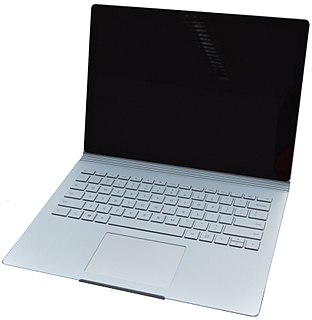
GeForce is a brand of graphics processing units (GPUs) designed by Nvidia. As of the GeForce 30 series, there have been seventeen iterations of the design. The first GeForce products were discrete GPUs designed for add-on graphics boards, intended for the high-margin PC gaming market, and later diversification of the product line covered all tiers of the PC graphics market, ranging from cost-sensitive GPUs integrated on motherboards, to mainstream add-in retail boards. Most recently, GeForce technology has been introduced into Nvidia's line of embedded application processors, designed for electronic handhelds and mobile handsets.

A graphics processing unit (GPU) is a specialized electronic circuit designed to manipulate and alter memory to accelerate the creation of images in a frame buffer intended for output to a display device. GPUs are used in embedded systems, mobile phones, personal computers, workstations, and game consoles.

Alienware is an American computer hardware subsidiary of Dell. Their product range is dedicated to gaming computers which can be identified by their alien-themed designs. Alienware was founded in 1996 by Nelson Gonzalez and Alex Aguila, and is currently led by Vivian Lien. The development of the company is also associated with Frank Azor, Arthur Lewis, Joe Balerdi, and Michael S. Dell. The company's corporate headquarters is located in The Hammocks, Miami, Florida.
Dell XPS is a line of consumer-oriented high-end laptop and desktop computers manufactured by Dell. The XPS mainly competes against computers such as Acer's Aspire, HP's Pavilion and Envy, Lenovo's X1, Samsung's Sens, and Apple MacBook Pro.

A 2-in-1 PC, also known as convertible laptop, 2-in-1 tablet, 2-in-1 laptop, 2-in-1 detachable, laplet, tabtop, laptop tablet, or simply 2-in-1, is a portable computer that has features of both tablets and laptops.
The M-series of desktops are part of Lenovo's ThinkCentre product line. Formerly an IBM brand, Lenovo acquired the ThinkCentre desktop brand following its purchase of IBM's Personal Computing Division (PCD) in 2005. Following its acquisition of IBM's PCD, Lenovo has released M-series desktops in multiple form factors, ranging from traditional tower, to small form factor, and all-in-ones (AIOs).

Lenovo Yoga is a line of consumer-oriented laptop computers and tablets designed, developed and marketed by Lenovo, named for their ability to assume multiple form factors due to a hinged screen.
Windows RT is a deprecated mobile operating system developed by Microsoft. It is a version of Windows 8 or Windows 8.1 built for the 32-bit ARM architecture (ARMv7). First unveiled in January 2011 at Consumer Electronics Show, the Windows RT 8 operating system was officially launched alongside Windows 8 on October 26, 2012, with the release of three Windows RT-based devices, including Microsoft's original Surface tablet. Unlike Windows 8, Windows RT is only available as preloaded software on devices specifically designed for the operating system by original equipment manufacturers (OEMs).

Microsoft Surface is a series of touchscreen-based personal computers, tablets and interactive whiteboards designed and developed by Microsoft, running the Microsoft Windows operating system, apart from the Surface Duo, which runs on Android. The devices are manufactured by original equipment manufacturers, including Pegatron, and are designed to be premium devices that set examples to Windows OEMs. It comprises seven generations of hybrid tablets, 2-in-1 detachable notebooks, a convertible desktop all-in-one, an interactive whiteboard, and various accessories all with unique form factors. The majority of the Surface lineup features Intel processors and are compatible with Microsoft's Windows 10 or Windows 11 operating system.

The Surface Pro 2 is a Surface-series 2-in-1 detachable produced by Microsoft. Unveiled at an event in New York City on September 23, 2013 and released on October 22, 2013, it succeeds the Surface Pro released in February 2013. While maintaining a design similar to the original design of its predecessor, the Surface Pro 2 has improved hardware specifications compared to it, such as a Haswell Intel Core processor and an increased number of storage options, improved versions of the kickstand and cover accessories.
Surface Mini is a unreleased tablet computer that Microsoft designed as the planned successor to the Surface 2 in the Microsoft Surface family. The device has a Qualcomm Snapdragon 800 processor and a 7.5-inch (19 cm) 4:3 aspect ratio touchscreen display that defaults to portrait mode. Like its predecessor, the Surface Mini runs Windows RT 8.1, a mobile operating system that was designed for the ARM architecture and has limitations including an inability to install Win32 applications; programs can only be installed from the Windows Store.

Surface 3 is a 2-in-1 detachable from the Microsoft Surface series, introduced by Microsoft in 2015. Unlike its predecessor, the Surface 2, Surface 3 utilizes an x86 Intel Atom system-on-chip architecture, or SoC, rather than a processor with ARM architecture such as the Nvidia Tegra that powered the Surface 2, and runs standard versions of Windows 8.1 or Windows 10.

Windows 10 is a major release of Microsoft's Windows NT operating system. It is the direct successor to Windows 8.1, which was released nearly two years earlier. It was released to manufacturing on July 15, 2015, and later to retail on July 29, 2015. Windows 10 was made available for download via MSDN and TechNet, as a free upgrade for retail copies of Windows 8 and Windows 8.1 users via the Windows Store, and to Windows 7 users via Windows Update. Windows 10 receives new builds on an ongoing basis, which are available at no additional cost to users, in addition to additional test builds of Windows 10, which are available to Windows Insiders. Devices in enterprise environments can receive these updates at a slower pace, or use long-term support milestones that only receive critical updates, such as security patches, over their ten-year lifespan of extended support. In June 2021, Microsoft announced that mainstream support for Windows 10 editions which are not in the Long-Term Servicing Channel (LTSC) ended on October 13, 2020 and extended support will end on October 14, 2025.

The Surface Hub is a brand of interactive whiteboard developed and marketed by Microsoft, as part of the Microsoft Surface family. The Surface Hub is a wall-mounted or roller-stand-mounted device with either a 55-inch (140 cm) 1080p or an 84-inch (210 cm) 4K 120 Hz touchscreen with multi-touch and multi-pen capabilities, running the Windows 10 operating system. The devices are targeted for businesses to use while collaborating and videoconferencing.

The Surface Book is a 2-in-1 PC designed and produced by Microsoft, part of the company's Surface line of personal computing devices. Surface Book is distinguished from other Surface devices primarily by its full-sized, detachable keyboard, which uses a dynamic fulcrum hinge that expands when it is opened. The keyboard contains a second battery, a number of ports and an optional discrete graphics card used when the screen part, also dubbed as the clipboard by Microsoft, is docked to it. Unlike Surface Pro devices, which are marketed as tablets, the Surface Book is marketed as a laptop, Microsoft's first device marketed as such. Unlike the Surface Laptop devices, the two parts are detachable.

The Surface Laptop is a laptop computer designed by Microsoft as part of the company's Surface line of personal computing devices. When it debuted, the laptop was intended to compete with Apple's MacBook Air and MacBook Pro

The fifth-generation Surface Pro is a Surface-series 2-in-1 detachable hybrid notebook computer, designed, developed, marketed, and produced by Microsoft. The Surface Pro was announced in May 2017 at a public event held in Shanghai, China. The device launched in 26 different markets on June 15.
The Surface Studio 2 is an all-in-one PC, designed and produced by Microsoft as part of its Surface series of Windows-based personal computing devices. It was announced at the Windows 10 Devices Event on October 2, 2018, two years after the release of the previous version Surface Studio, with pre-orders beginning that day.
Surface Laptop Studio is a newly introduced product line by Microsoft at their Surface Event on September 22, 2021. It was announced by the company alongside the Surface Go 3 and Surface Pro 8, Surface Duo 2 and several Surface accessories. The device is a new form factor featuring a dual-pivoting screen that flips into tablet mode. The laptop is powered by Windows 11 operating system.
The Surface Laptop Go 2 is an upgrade to the Surface Laptop Go. It is a mid-range portable computer with adequate capabilities for everyday PC use that is part of the company's Surface line of personal computing devices. The newer 11th-gen Intel Core i5-1135G7 processor and slightly enhanced 128 GB basic storage will be the laptop's key highlights. Microsoft announced the Surface Laptop Go 2 in a new Sage color on June 1, 2022.















